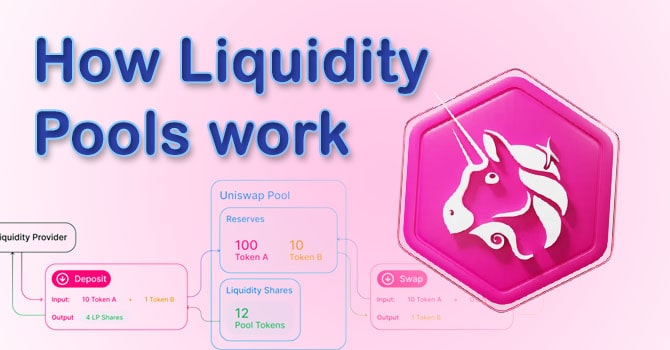
- Content:
- ...
- 1. Concept of liquidity
- 2. What is a liquidity pool in Uniswap V2
- 3. How does the liquidity pool work?
- 3.1. Creation of a Liquidity Pool
- 3.2. Token pricing
- 3.2. Token swap
- 4. If I invested $1000 in liquidity, does this mean that someone can buy all the tokens for $1000?
- 5. Results
Note:
- In this article, we will not dive into the technical aspects of the work of the Uniswap V2 protocols, but will briefly understand the principle of operation of liquidity pools, and also answer popular questions on this topic.
- As mentioned, the focus today is on V2 liquidity, since the protocols of this version are still the most popular and are used in most smart token contracts.
Concept of liquidity
Liquidity is a key element of decentralized finance in the world of cryptocurrencies. In simple terms, liquidity means how quickly and easily a token can be bought or sold. If a trading pair (for example USDC-WETH) has high liquidity, this means that many people are willing to buy or sell the token, and the price changes smoothly and quickly.
Low liquidity, on the other hand, means that trades can take longer and the price can fluctuate wildly.
Liquidity is important because it makes the market more predictable and accessible to participants, allowing them to exchange cryptocurrency quickly and seamlessly.
What is a liquidity pool in Uniswap V2
Liquidity Pool on Uniswap V2 is a cryptocurrency exchange. A place where a pair of tokens (for example, the same USDC-WETH) is stored and ready for exchange.
It works based on AMM (Automated Market Maker), which means prices are set automatically based on the amount of cryptocurrency in the pool.
So, when you exchange your cryptocurrency on Uniswap V2 , you receive another cryptocurrency from the pool and the price is calculated without any middleman. This makes the cryptocurrency exchange process decentralized.
How does the liquidity pool work
All the magic of the liquidity pool is provided by the above-mentioned AMM. On Uniswap V2, Automated Market Maker (AMM) is the key mechanism enabling the exchange and pricing of cryptocurrencies in a decentralized
Here's how it works:
Creation of a Liquidity Pool:
A liquidity pool is created by depositing two different cryptocurrencies in a certain ratio.
❮ For example ❯
you created your own MTK token. We contribute, say, 1 WETH and 4000 MTK to the pool, which creates the starting price: 1 WETH = 4000 MTK. This means that one ether is worth 4000 MTK tokens.
These assets are paired and the pool is ready for exchange. Now people can buy and sell your tokens.
Token Pricing:
Once the liquidity pool is created, any user can start trading WETH and USDC. If someone wants to buy WETH, they send USDC to the pool and the price of WETH starts to rise.
Conversely, if someone wants to sell WETH, they send WETH to the pool and the price of WETH begins to decrease.
The basis for pricing on Uniswap V2 is the equality of product principle.
This means that the product of the amount of WETH and USDC in the pool should always remain constant.
❮ For example ❯
if the pool had 1 WETH and 4000 MTK (product = 1 * 4000 = 4000), then after the exchange, the product remains unchanged. If someone bought 0.5 WETH, the amount of WETH in the pool will decrease, but the price of WETH will increase so that the product remains at 4000.
Token swap:
When you want to make a trade, for example buy 100 MTK, you submit WETH to the pool and the system automatically calculates the MTK price based on the equality of the product. You will receive 100 MTK at the current price.
This mechanism allows the market to quickly respond to supply and demand, and the price is formed without the need to wait for the consent of the seller or buyer.
This makes Uniswap V2 and AMM more flexible and decentralized than traditional exchanges.
If I invested $1000 in liquidity, does this mean that someone can buy all the tokens for $1000?
The short answer is no. The Uniswap protocol is designed in such a way that if you have $1000 in the liquidity pool and you try to buy $1000 worth of tokens, you will only receive 49% of the tokens.
Let's look at an example of how many ETH tokens you will have to give in order to buy a certain amount of MTK.
❮ For example - 1 ❯
let's say that WETH-MTK's liquidity pool currently contains 1 ETH and 1000 MTK. Then, in quantitative terms, the table will look like this:

The same statistics, but in percentage terms
❮ For example - 2 ❯
to buy 10% of the available MTK tokens, you will have to spend ETH in the amount of 11% of what is in the pool.

Thus, to redeem 99.9% of MTK tokens from the liquidity pool, you will need about 100100% of the ETH that is in the liquidity pool.
Results:
In this article, we tried to outline in simple language, without delving into the technical aspects of the protocol, the principles of operation of liquidity pools.
Understanding them will greatly simplify your life in the world of decentralized finance and even when launching your own token.
launching your own token ➥
📰 MORE TOP HEADLINES

